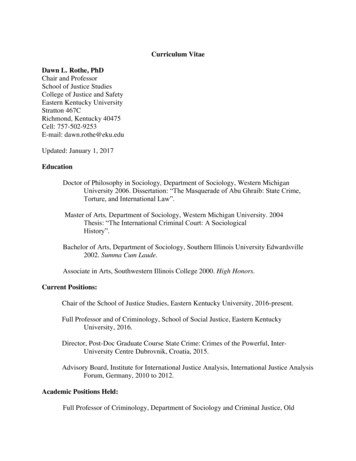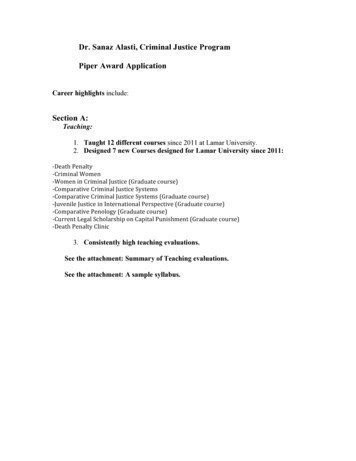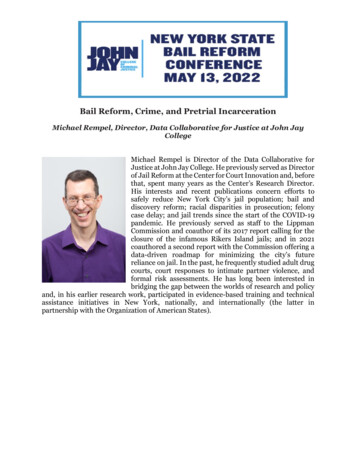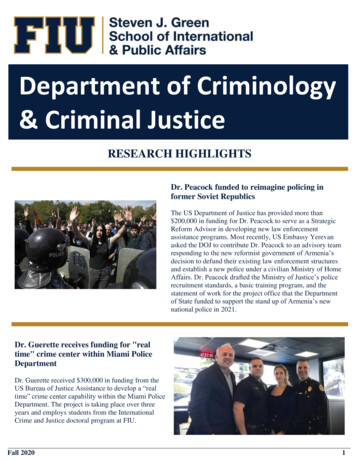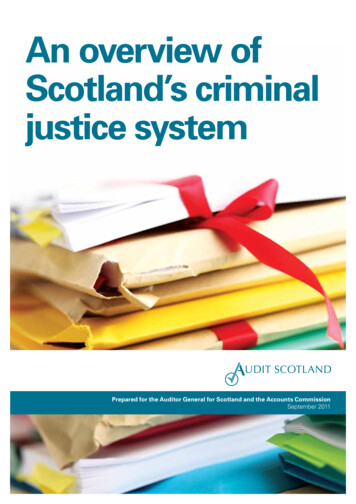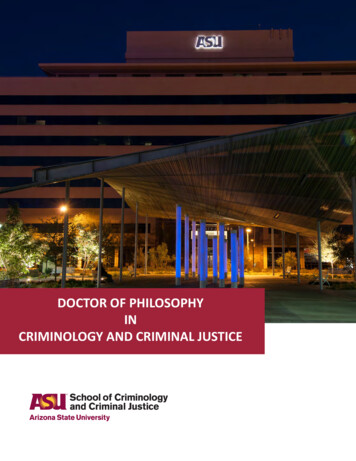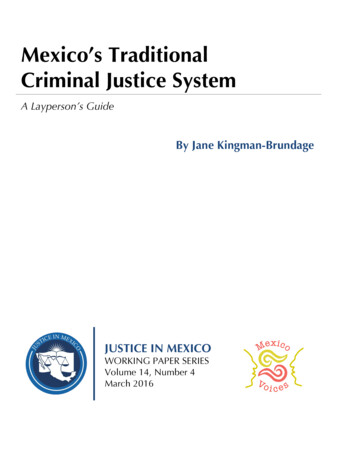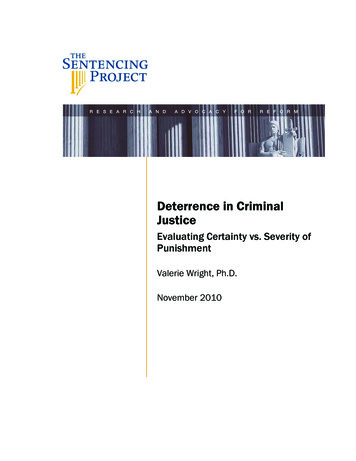
Transcription
Deterrence in CriminalJusticeEvaluating Certainty vs. Severity ofPunishmentValerie Wright, Ph.D.November 2010
For further information:The Sentencing Project1705 DeSales St., NWThis report was written by Valerie Wright, Ph.D., Research Analyst atThe Sentencing Project.The Sentencing Project is a national non-profit organization engagedin research and advocacy on criminal justice policy issues.8th FloorWashington, D.C. 20036(202) 628-0871www.sentencingproject.orgCopyright 2010 by The Sentencing Project. Reproduction of thisdocument in full or part in print or electronic format only by permission ofThe Sentencing Project.
DETERRENCE IN CRIMINAL JUSTICE EVALUATING CERTAINTY VERSUS SEVERITY OF PUNISHMENTO1ver the past several decades state and federal incarceration rates haveincreased dramatically. As a consequence of more punitive laws andharsher sentencing policies 2.3 million people are incarcerated in thenation’s prisons and jails, and the U.S. leads the world in its rate of incarceration.Sentencing systems and incarceration traditionally have a variety of goals, whichinclude incapacitation, punishment, deterrence and rehabilitation. In recent decades,sentencing policy initiatives have often been enacted with the goal of enhancing thedeterrent effect of the criminal justice system. Under the rubric of “getting tough oncrime,” policies such as mandatory minimums, truth in sentencing, and “three strikesand you’re out” have been designed to deter with the threat of imposing substantialterms of imprisonment for felony convictions.While the criminal justice system as a whole provides some deterrent effect, a keyquestion for policy development regards whether enhanced sanctions or an enhancedpossibility of being apprehended provide any additional deterrent benefits. Researchto date generally indicates that increases in the certainty of punishment, as opposed tothe severity of punishment, are more likely to produce deterrent benefits. Thisbriefing paper provides an overview of criminological research on these relativeimpacts as a guide to inform future policy consideration.
DETERRENCE IN CRIMINAL JUSTICE EVALUATING CERTAINTY VERSUS SEVERITY OF PUNISHMENT2CONCEPTUALIZING DETERRENCEIn broad terms punishment may be expected to affect deterrence in one of two ways.First, by increasing the certainty of punishment, potential offenders may be deterredby the risk of apprehension. For example, if there is an increase in the number ofstate troopers patrolling highways on a holiday weekend, some drivers may reducetheir speed in order to avoid receiving a ticket. Second, the severity of punishmentmay influence behavior if potential offenders weigh the consequences of their actionsand conclude that the risks of punishment are too severe. This is part of the logicbehind “three strikes,” and “truth in sentencing” policies, to utilize the threat of verysevere sentences in order to deter some persons from engaging in criminal behavior.One problem with deterrence theory is that it assumes that human beings are rationalactors who consider the consequences of their behavior before deciding to commit acrime; however, this is often not the case. For example, half of all state prisonerswere under the influence of drugs or alcohol at the time of their offense.1 Therefore,it is unlikely that such persons are deterred by either the certainty or severity ofpunishment because of their temporarily impaired capacity to consider the pros andcons of their actions.Another means of understanding why deterrence is more limited than often assumedcan be seen by considering the dynamics of the criminal justice system. If there was100% certainty of being apprehended for committing a crime, few people would doso. But since most crimes, including serious ones, do not result in an arrest andconviction, the overall deterrent effect of the certainty of punishment is substantiallyreduced. Clearly, enhancing the severity of punishment will have little impact onpeople who do not believe they will be apprehended for their actions.1Christopher Mumola. “Substance Abuse and Treatment, State and Federal Prisoners, 1997.” Bureau of JusticeStatistics Special Report, 1999.
DETERRENCE IN CRIMINAL JUSTICE EVALUATING CERTAINTY VERSUS SEVERITY OF PUNISHMENT3Economists often come to different conclusions than criminologists on the value ofharsher sentences in reducing crime. While criminologists tend to regard variouslegal threats as the result of a complex and unpredictable process, economistsapproach the issue along the lines of a rational choice perspective that considers therisk and benefits of engaging in crime; sanctions merely represent the expected priceof engaging in criminal behavior. In critiquing this perspective, Michael Tonry, aleading scholar on crime and punishment, contends that “Such research is incapableof taking into account whether and to what extent purported policy changes areimplemented, whether and to what extent their adoption or implementation isperceived by would-be offenders, and whether and to what extent offenders aresusceptible to influence by perceived changes in legal threats. At the very least,macro-level research on deterrent effects should test the null hypothesis of no effectrather than the price theory assumption that offenders’ behavior will change inresponse to changes in legal threats.”2Another problem in assessing deterrence is that in order for sanctions to deter,potential offenders must be aware of sanction risks and consequences before theycommit an offense. In this regard, research illustrates that the general public tends tounderestimate the severity of sanctions generally imposed.3, 4 This is not surprisinggiven that members of the public are often unaware of the specifics of sentencingpolicies. Potential offenders are also unlikely to be aware of modifications tosentencing policies, thus diminishing any deterrent effect. The absence of such dataon awareness of punishment risks makes it difficult to draw conclusions regarding thedeterrent effects of sanction levels and prospects. Below we explore these outcomesin greater detail.2Michael Tonry. “Learning from the Limitations of Deterrence Research” in Crime and Justice: A Review of Researchedited by Michael Tonry. The University of Chicago Press, 2008.3Kirk R. Williams, Jack P. Gibbs, and Maynard L. Erickson, “Public Knowledge of Statutory Penalties: The Extent andBasis of Accurate Perception,” Pacific Sociological Review, 23(1), 1980.4Andrew von Hirsch, Anthony Bottoms, Elizabeth Burney, and P-O. Wikstrom, “Criminal Deterrence and SentenceSeverity: An Analysis of Recent Research,” Oxford: Hart Publishing, 1999.
DETERRENCE IN CRIMINAL JUSTICE EVALUATING CERTAINTY VERSUS SEVERITY OF PUNISHMENT4CERTAINTY VS. SEVERITY OF PUNISHMENTCriminological research over several decades and in various nations generallyconcludes that enhancing the certainty of punishment produces a stronger deterrenteffect than increasing the severity of punishment. Key findings in this regard includethe following: The Institute of Criminology at Cambridge University was commissioned bythe British Home Office to conduct a review of research on major studies ofdeterrence. Their 1999 report concluded that “ the studies reviewed do notprovide a basis for inferring that increasing the severity of sentences generallyis capable of enhancing deterrent effects.”5 In addition, in reviewing macrolevel studies that examine offense rates of a specific population, theresearchers found than an increased likelihood (certainty) of apprehensionand punishment was associated with declining crime rates.6 Daniel Nagin and Greg Pogarsky, leading scholars on deterrence, concludethat “punishment certainty is far more consistently found to deter crime thanpunishment severity, and the extra-legal consequences of crime seem at leastas great a deterrent as the legal consequences.”7Similar findings are observed in micro-level studies on deterrence that assess thelikelihood of individuals engaging in crime. People who perceive that sanctions aremore certain tend to be less likely to engage in criminal activity. Scenario-basedresearch using self-reports that examine the effect of certainty of punishment onindividual behavior has shown that as the perceptions of the risk of arrest for petty5Ibid.6Ibid.7Daniel Nagin and Greg Pogarsky. “Integrating Celerity, Impulsivity, and Extralegal Sanction Threats into a Model ofGeneral Deterrence: Theory and Evidence,” Criminology, 39(4), 2001.
DETERRENCE IN CRIMINAL JUSTICE EVALUATING CERTAINTY VERSUS SEVERITY OF PUNISHMENT5theft, drunk driving, and tax evasion increases, individuals report they would be lesslikely to offend.Researchers have also compared the relative importance of both certainty and severityas dimensions of punishment. In a 2001 study published in the journal Criminology,researchers utilized a sample of college students to assess the likelihood of drinkingand driving. The authors found that the certainty of punishment was a more robustpredictor of deterrence than severity. Increasing the probability of apprehension by10% was predicted to reduce the likelihood of drunk driving by 3.5%, while theeffect of severity eroded when the effects of certainty and severity were combined.8In another study, researchers compared crime and punishment trends in the U.S.,England, and Sweden, and failed to find an effect for severity. 9 The statisticalassociations were weak and even when there was a negative relationship betweenseverity of punishment and crime rates, the findings were not strong enough toachieve statistical significance. This finding is noteworthy because it reflectedvarying degrees of punitiveness in the sentencing policies of the three nations.While most studies suggest that certainty of punishment is related to reductions incrime rates, some researchers speculate that increasing the likelihood of arrest and/orincarceration for both serious and minor offenses could cause sanctions, particularlyimprisonment, to be viewed as less stigmatizing.10 Nagin also emphasizes thatsanctions have the potential to erode the deterrent effects of a policy because as hestates, “[f]or an event to be stigmatizing it must be relatively uncommon.”118Ibid.9David Farrington, Paul Langan, Per-Olof H. Wikstrom. “Changes in Crime and Punishment in America, Englandand Sweden between the 1980s and the 1990s,” Studies in Crime Prevention, 3:104-131, 1994.10Paul J. Hirschfield, “The Declining Significance of Delinquent Labels in Disadvantaged Urban Communities,”Sociological Forum, 23(3), 2008.11Daniel S. Nagin, “Criminal Deterrence Research at the Outset of the Twenty-First Century,” In Crime and Justice: AReview of Research, edited by Michael Tonry. Chicago: University of Chicago Press, 1998.
DETERRENCE IN CRIMINAL JUSTICE EVALUATING CERTAINTY VERSUS SEVERITY OF PUNISHMENT6MORE SEVERE SENTENCES FAIL TO ENHANCEPUBLIC SAFETYThe logic behind supporting harsher sentences is simple: locking up people forlonger periods of time should enhance public safety. From this view, putting peoplein prison for years or even decades should prevent offenders from re-offending byincapacitating them and/or deterring would-be-offenders from committing crimes.However, contrary to deterrence ideology and “get tough” rhetoric, the bulk ofresearch on the deterrent effects of harsher sentences fails to support theseassertions.12A series of studies have examined the public safety effects of imposing longer periodsof imprisonment.13, 14, 15 Ideally, from a deterrence perspective, the more severe theimposed sentence, the less likely offenders should be to re-offend. A 1999 studytested this assumption in a meta-analysis reviewing 50 studies dating back to 1958involving a total of 336,052 offenders with various offenses and criminal histories.Controlling for risk factors such as criminal history and substance abuse, the authorsassessed the relationship between length of time in prison and recidivism, and foundthat longer prison sentences were associated with a three percent increase inrecidivism. Offenders who spent an average of 30 months in prison had a recidivismrate of 29%, compared to a 26% rate among prisoners serving an average sentence of12.9 months. The authors also assessed the impact of serving a prison sentenceversus receiving a community-based sanction. Similarly, being incarcerated versus12Anthony Doob and Cheryl Webster, “Sentence Severity and Crime: Accepting the Null Hypotheses,” Crime andJustice, 30:143-195, 2003.13Paul Gendreau, T. Little, and Claire Goggin, “A Meta-Analysis of Adult Offender Recidivism: What Works!”Criminology, 34(3):575-607, 1996.14Martin A. Levin, “Policy Evaluation and Recidivism,” Law and Society Review, 6(1):17-46, 1971.15Lin Song and Roxanne Lieb, “Recidivism: The Effect of Incarceration and Length of Time Served,” Olympia, WA:Washington State Institute of Public Policy, 1993
DETERRENCE IN CRIMINAL JUSTICE EVALUATING CERTAINTY VERSUS SEVERITY OF PUNISHMENT7remaining in the community was associated with a seven percent increase inrecidivism.16Researchers also find an increased likelihood that lower-risk offenders will be morenegatively affected by incarceration.17 Among low-risk offenders, those who spentless time in prison were 4% less likely to recidivate than low-risk offenders whoserved longer sentences.18 Thus, when prison sentences are relatively short, offendersare more likely to maintain their ties to family, employers, and their community, allof which promote successful reentry into society. Conversely, when prisoners servelonger sentences they are more likely to become institutionalized, lose pro-socialcontacts in the community, and become removed from legitimate opportunities, allof which promote recidivism.19The Bureau of Justice Statistics has reported on a nationally representative sample ofprisoners assessing the impact of time served in prison on recidivism rates.Researchers found that recidivism rates did not vary substantially whether prisonerswere released anywhere in the range of six months to five years. While recidivismrates were high in general, they fluctuated in the range of 62-68%, and did notdecline significantly for those spending more time in prison.20 Furthermore, findingsfrom a natural experiment investigating how prisoners respond to the manipulationof prison sentences show that reduced sentences may reduce recidivism rates. TheCollective Clemency Bill passed by the Italian Parliament in July 2006 allowed for athree-year sentence reduction for persons who committed their offense prior to May16Paul Gendreau, Claire Goggin, and Francis T. Cullen, “The Effects of Prison Sentences on Recidivism,” Ottawa,Ontario, Canada: Public Works and Government Services Canada, 1999.17Ibid.18Supra, note 15.19Thomas Orsagh and Jong-Rong Chen, “The Effect of Time Served on Recidivism: An Interdisciplinary Theory,”Journal of Quantitative Criminology, 4(2):155-171, 1988.20Patrick Langan and David Levin. “Recidivism of Prisoners Released in 1994,” U.S. Department of Justice, Office ofJustice Programs, Bureau of Justice Statistics, 2002.
DETERRENCE IN CRIMINAL JUSTICE EVALUATING CERTAINTY VERSUS SEVERITY OF PUNISHMENT82, 2006.21 The authors of the study concluded that the sentence commutationssignificantly reduced the likelihood of recidivating.22ECONOMIC COSTS OF MORE SEVERE SENTENCESFiscal crises and a growing emphasis on using evidence-based practices has causedmany policymakers to call into question the practicality of current sentencing policiesand the overreliance on incarceration. Incarceration is an expensive sanction andsentencing people to longer prison terms has resulted in valuable resources beingdevoured. It is estimated that federal, state, and local governments are spending 68billion annually.23 A recent economic analysis estimates that reducing the number ofincarcerated non-violent offenders by half could save taxpayers 16.9 billion annuallywithout putting public safety at risk.24Non-violent drug offenders comprise a substantial percentage of the prisonpopulation and many studies have suggested that this number could be reduced ifmore treatment alternatives were available. While there are costs associated withtreatment, research indicates that they tend to be far lower than the costs associatedwith lengthy terms of incarceration that show little evidence of deterring futureoffenses. For example, a recent study showed that spending on drug treatment incommunity-based programs versus incarceration yields a higher return on theinvestment while at the same time improving the life outcomes of drug users. Thestudy concluded that a dollar spent on treatment in prison yields about six dollars of21The Collective Clemency Bill (2006) states that if a former inmate commits a crime within five years following hisrelease from prison, he or she will be required to serve the remaining sentence suspended by the pardon in addition tothe sentence given for the new crime.22Fancesco Drago, Roberto Galbiati, and Pietro Vertova, “The Deterrent Effects of Prison: Evidence from a NaturalExperiment,” Journal of Political Economy, 117(2):257-280 2009.23John Schmitt, Kris Warner, and Sarika Gupta. “The High Budgetary Cost of Incarceration,” Center for Economicand Policy Research, 2010.24Ibid.
DETERRENCE IN CRIMINAL JUSTICE EVALUATING CERTAINTY VERSUS SEVERITY OF PUNISHMENT9savings, but a dollar investment in community-based treatment yields nearly 20 incosts savings.25CONCLUSIONExisting evidence does not support any significant public safety benefit of thepractice of increasing the severity of sentences by imposing longer prison terms. Infact, research findings imply that increasingly lengthy prison terms arecounterproductive. Overall, the evidence indicates that the deterrent effect oflengthy prison sentences would not be substantially diminished if punishments werereduced from their current levels. Thus, policies such as California’s Three Strikeslaw or mandatory minimums that increase imprisonment not only burden statebudgets, but also fail to enhance public safety. As a result, such policies are notjustifiable based on their ability to deter.Based upon the existing evidence, both crime and imprisonment can besimultaneously reduced if policy-makers reconsider their overreliance on severitybased policies such as long prison sentences. Instead, an evidence-based approachwould entail increasing the certainty of punishment by improving the likelihood thatcriminal behavior would be detected. Such an approach would also free up resourcesdevoted to incarceration and allow for increased initiatives of prevention andtreatment.25Steve Aos, Marna Miller, and Elizabeth Drake, “Evidence-Based Public Policy Options to Reduce Future PrisonConstruction, Criminal Justice Costs, and Crime Rates,” Olympia: Washington State Institute for Public Policy, 2006.
1705 DeSales Street, NW, 8th floorWashington, DC 20036Tel: 202.628.0871 Fax: 202.628.1091www.sentencingproject.org
involving a total of 336,052 offenders with various offenses and criminal histories. Controlling for risk factors such as criminal history and substance abuse, the authors assessed the relationship between length of time in prison and recidivism, and found that longer prison sentences were associated with a three percent increase in recidivism.



